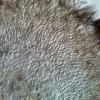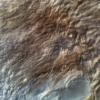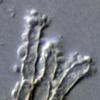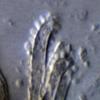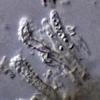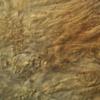
16-03-2014 22:00
Hello,I found this species a few months ago but ha

08-12-2025 13:39
Thomas Læssøehttps://svampe.databasen.org/observations/10572899

07-12-2025 16:07
Arnold BüschlenHallo, ich habe in einer Moos-Aufsammlung (epiohy

05-12-2025 17:33
 Bruno Coué
Bruno Coué
Bonjour, je serais heureux de recueillir votre avi

07-12-2025 09:24
De la pasada semana en Galicia EspañaEn el suelo

06-12-2025 00:19
 Viktorie Halasu
Viktorie Halasu
Hello, would anyone have this article, please? An
Unguiculariopsis-like on Eutypa
Chris Yeates,
01-03-2015 16:25
 Bonjour tous
Bonjour tousI collected this intriguing discomycete a couple of days ago on a small decorticated branch well covered with Eutypa (I suspect the tree was Acer pseudoplatanus).
When I saw the globose spores and iodine negative (both IKI & MLZ) asci, these combined made me think of Unguiculariopsis, a genus with few British records. I have collected U. ilicincola some years ago (on Ilex), and that is the total of my familiarity with the genus. I find Zhuang's monograph useful, but not completely so.
I would have assumed this to be U. ilicincola but for the fact that the excipular margin is completely different from what I expected. There is no evidence of the uncinate terminal cells one would expect, very well shown in Enrique's http://www.ascofrance.fr/search_recolte/3899
The excipulum consists of thick walled glassy cells which elongate towards the margin where they end as pigmented and lying more or less parallel. In addition a considerable number of these terminal cells bear an ornamentation of small globose bodies, which seem to be a part of the cell wall rather than a superficial coating (for example they were unaffected by 5% KOH). Perhaps the images will explain this better. I shall post images in more than one tranche as there are quite a few.
Details of the fungus are:
apothecia mostly in the region of 300-400µm when mature on ? Acer pseudoplatanus branch covered by a Eutypa species, many apo's on areas covered with damp algal growth
asci 8-spored J-, with croziers
ascospores spherical 2.7-3.3µm (so far too small for ilicincola ?)
paraphyses more or less parallel-sided; in MLZ (but not in IKI) they produced tiny globose iodine (?) particles, as can be seen in one of the photographs
excipulum as explained above (images will follow as a second batch)
any suggestions more than welcome
amitiés
Chris
Andreas Gminder,
01-03-2015 16:38

Re : Unguiculariopsis-like on Eutypa
Hello Chris,
may be a Hyphodiscus, like hypothejus or something similar?
best regards,
Andreas
Chris Yeates,
01-03-2015 17:14

Re : Unguiculariopsis-like on Eutypa
Hallo Andreas
that is a very interesting suggestion, for which many thanks; on checking W. Zhuang's "Notes on Lachnellula theiodea" Mycotaxon XXXI, pp. 411-416 I am pretty sure that I have Hyphodiscus theiodeus as so many of the characters fit perfectly.
It is encouraging to read in that paper a quote from Richard Korf re this taxon " . . . .the ectal excipular layer of this discomycete is unlike that known to me in any other of the 'hairy inoperculate discomycetes' " - I don't feel so bad now about being baffled initially by the structure of the excipulum. I attach the relevant paper for completeness. I shall post my final images in a while. The only 'fly in the ointment' is that I could not see an iodine reaction at the ascus apex - I shall revisit that before drying the material.
LG
Chris
that is a very interesting suggestion, for which many thanks; on checking W. Zhuang's "Notes on Lachnellula theiodea" Mycotaxon XXXI, pp. 411-416 I am pretty sure that I have Hyphodiscus theiodeus as so many of the characters fit perfectly.
It is encouraging to read in that paper a quote from Richard Korf re this taxon " . . . .the ectal excipular layer of this discomycete is unlike that known to me in any other of the 'hairy inoperculate discomycetes' " - I don't feel so bad now about being baffled initially by the structure of the excipulum. I attach the relevant paper for completeness. I shall post my final images in a while. The only 'fly in the ointment' is that I could not see an iodine reaction at the ascus apex - I shall revisit that before drying the material.
LG
Chris
Chris Yeates,
01-03-2015 20:13
Hans-Otto Baral,
02-03-2015 22:46

Re : Unguiculariopsis-like on Eutypa
Hi Chris
I did not read through your description because I thought the case is clear. Now you drew my attention by email to the inamyloid asci. Indeed, usually the species has hemiamyloid rings, while some species with ellipsoid spores exist having inamyloid asci. But I have a single collection of H. theiodeus (HB 8516b) which was also totally inamyloid. Images in Cubby, here my text to them:
Sjaelland, Allindelille Fredskov, Fagus branch c. 1.5 m above ground, on Peniophora. Ap. rehydr. 0.15-0.35 mm diam. Asci *35-45 x 5.7-6(-6.3) µm, with croziers, IKI-!, K+IKI dto. (2 ap. tested). Sp. *2.5-2.7(-3) x 2.4-2.6(-2.8) µm. Paraph. filled with 1refr. small or large guttules far down. Ectexc. near base partly covered by yellow pigment.
Zotto
I did not read through your description because I thought the case is clear. Now you drew my attention by email to the inamyloid asci. Indeed, usually the species has hemiamyloid rings, while some species with ellipsoid spores exist having inamyloid asci. But I have a single collection of H. theiodeus (HB 8516b) which was also totally inamyloid. Images in Cubby, here my text to them:
Sjaelland, Allindelille Fredskov, Fagus branch c. 1.5 m above ground, on Peniophora. Ap. rehydr. 0.15-0.35 mm diam. Asci *35-45 x 5.7-6(-6.3) µm, with croziers, IKI-!, K+IKI dto. (2 ap. tested). Sp. *2.5-2.7(-3) x 2.4-2.6(-2.8) µm. Paraph. filled with 1refr. small or large guttules far down. Ectexc. near base partly covered by yellow pigment.
Zotto
Chris Yeates,
02-03-2015 23:21

Re : Unguiculariopsis-like on Eutypa
Many thanks for that information, Zotto; this is apparently only the second time this species has been recorded for the British Isles: http://www.fieldmycology.net/FRDBI/FRDBIrecord.asp?intGBNum=45183
Best wishes
Chris
Best wishes
Chris

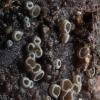
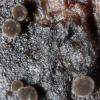
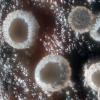
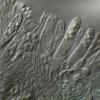
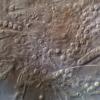
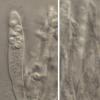
 Mycotaxon-1988-31-411-0001.pdf
Mycotaxon-1988-31-411-0001.pdf